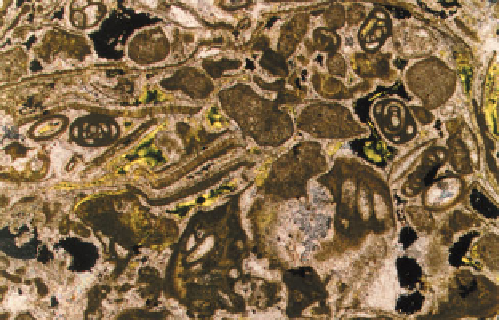Geoscience Reference
In-Depth Information
No section on building limestones would be complete
without mentioning the Pyramids of Giza in Egypt. The
cores of the pyramids were built from blocks of the local
Eocene limestone (Mokattam Formation). Figure
68
shows
this fine-grained, buff/cream-coloured biomicrite that
comprises 30-50% foraminifera microfossils (mainly
Nummulities) and 50-70% micrite matrix. The casing
stones for the pyramids were quarried at Tura on the
opposite (east) side of the River Nile. Here, the same rock
(Mokattam Formation) is finer-grained and it was for this
quality (and its ability to form tighter joints) that it was
selected for use as casing blocks. Figure
69
shows this
'Tura' limestone, which is a very fine-grained, sparse
biomicrite comprising approximately 10% microfossil
fragments and 90% micrite matrix. In 1974 a radical
theory was proposed that involved the pyramid casing
stones being cast
in situ
as geopolymer 'concrete', rather
than being natural stone from the Tura quarries. This
theory has recently been disproved by a petrographic
study (Jana, 2007).
Dolomite (also called magnesian limestone) is named
after the mineral dolomite CaMg(CO
3
)
2
that it contains. It is
formed from limestone by chemical reactions during
diagenesis. Dolomitic rocks are classified according to their
percentage content of the dolomite mineral as follows:
• 0-10% dolomite = limestone.
• 10-50% dolomite = dolomitic limestone.
• 50-90% dolomite = calcitic dolomite.
• 90-100% dolomite = dolomite.
68
Dolostones are used locally for building, with a famous
example being the Magnesian Limestone (Cadeby Forma-
tion, Upper Permian) of Yorkshire, England. Petrographi-
cally, the Magnesian Limestone shows a wide range of
textures. Figure
70
shows 'Hampole', a dolomitic limestone
with the bioclastic texture of the original limestone, still
partially preserved despite being dolomitized.
68
Mokattam Formation limestone (Egypt) consisting
of Nummulities bioclasts (white) cemented by
microcrystalline calcite (micrite, brown). From the
core of Khafre's Pyramid at Giza; XPT, ×25.
69
70
69
'Tura' limestone (Egypt) consisting of sparse
microfossil shell fragments (pink) set in a matrix
microcrystalline calcite (micrite, brown). From the
casing of Khafre's Pyramid at Giza; XPT, ×150.
70
'Hampole' dolomitic limestone (Yorkshire,
England) consisting of bryozoans, coral, and shell
fragment bioclasts (brown) with a mantle of dolomite
crystals (pink). Macropores are shown yellow/green;
XPT, ×35.






